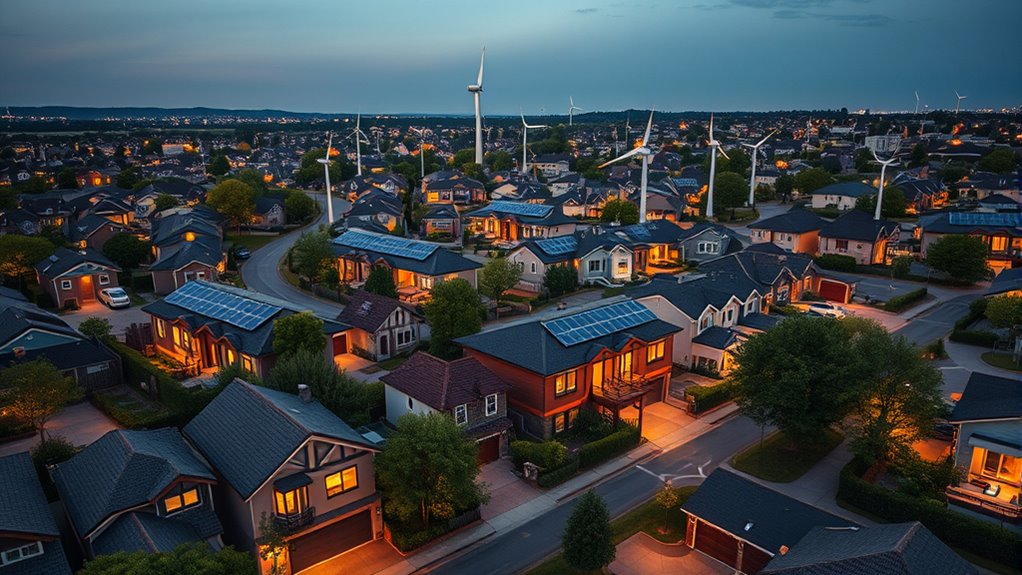Circular microgrids let your neighborhood generate, store, and profit from renewable energy like solar and wind. By owning and managing your energy system, you gain independence from external providers and improve resilience during outages. Excess power can be sold back to the main grid, creating a new income stream. This way, your community becomes more sustainable and economically self-sufficient. If you want to discover how this works and benefits your neighborhood, keep exploring the potential of circular microgrids.
Key Takeaways
- Circular microgrids enable neighborhoods to generate, store, and share renewable energy locally, enhancing self-sufficiency.
- They facilitate selling excess energy back to the main grid, creating revenue streams for communities.
- Digital management tools optimize energy flow, improving efficiency and profitability within the microgrid.
- Community-driven microgrids promote sustainability, resilience, and control over local energy resources.
- Local energy generation reduces reliance on external sources, lowering costs and supporting economic growth.

Have you ever wondered how communities can become more sustainable and resilient? One effective way is through the development of circular microgrids—localized energy systems that generate, store, and distribute power within a neighborhood. These microgrids aren’t just about producing clean energy; they’re about creating a self-sufficient, adaptable network that benefits everyone involved. By integrating energy storage solutions, you can guarantee a steady power supply even when the sun isn’t shining or the wind isn’t blowing. This storage capability is vital for maintaining grid resilience, allowing your community to withstand outages and reduce reliance on distant, centralized power plants. When your neighborhood can store excess energy during peak production times, it becomes a buffer that stabilizes the entire system, making it more reliable.
Imagine a microgrid where solar panels and wind turbines are installed on rooftops and vacant lots, capturing renewable energy directly from your environment. This local generation reduces transmission losses and cuts down on pollution, directly benefiting your community’s health and environment. But the real magic happens when this energy is stored efficiently. With advanced energy storage systems, your neighborhood can draw on its reserves during cloudy days or calm nights, guaranteeing a continuous power supply. This not only keeps your lights on and appliances running but also enhances the overall resilience of your local grid. When disruptions occur—whether due to storms, technical failures, or other emergencies—the microgrid can operate independently from the main grid, providing a secure source of energy and preventing widespread blackouts.
Local renewable energy and storage boost resilience and keep your community powered during outages.
Additionally, incorporating digital platforms for monitoring and managing energy flow can optimize system performance and efficiency in real-time. Furthermore, microgrids open up opportunities for your community to generate profits. Excess energy produced during sunny or windy days can be sold back to the main grid, creating a new revenue stream. This income can be reinvested into further renewable projects or infrastructure upgrades, making your neighborhood more sustainable over time. Additionally, as local energy management becomes more efficient, your community can lower energy costs for residents and businesses alike. This financial benefit, combined with increased energy independence, makes circular microgrids a smart choice for neighborhoods looking to boost their resilience and sustainability.
In essence, by focusing on energy storage and grid resilience, you’re empowering your community to take control of its energy future. Circular microgrids foster a decentralized, flexible, and environmentally friendly energy ecosystem that benefits everyone. They turn your neighborhood into a proactive participant in the energy transition, reducing reliance on external sources and creating a more resilient, profitable, and sustainable community for years to come.
Frequently Asked Questions
How Do Microgrids Integrate With Existing Power Grids?
You can integrate microgrids with existing power grids by connecting them through smart controls and communication systems. This allows for seamless renewable integration, balancing supply and demand efficiently. Microgrids enhance grid resilience by providing localized power during outages and reducing stress on the main grid. Active management guarantees stable energy flow, enabling neighborhoods to generate their own power while supporting overall grid stability and sustainability.
What Are the Initial Costs for Establishing a Circular Microgrid?
The initial investment for a circular microgrid includes infrastructure costs like installing renewable energy sources, storage systems, and smart grid technology. You’ll need to budget for equipment, construction, and integration with existing power systems. These infrastructure costs vary based on size and technology, but investing upfront helps you gain long-term energy independence, potential profits, and resilience. Planning carefully guarantees you cover all necessary components and avoid unexpected expenses down the line.
How Do Microgrids Ensure Energy Reliability During Outages?
During outages, microgrids keep your power dependable by using energy storage systems that supply electricity when main grids fail. They actively manage outages through outage management strategies, isolating affected areas and rerouting power. This guarantees your neighborhood maintains essential services without interruption. By balancing supply and demand and quickly responding to issues, microgrids provide a resilient energy system that keeps your lights on even during disruptions.
Can Microgrids Adapt to Different Community Sizes?
Perfectly pinpointing community scalability, microgrids adapt seamlessly to different community sizes by scaling up or down with ease. They’re flexible, fitting small neighborhoods or sprawling districts, ensuring size adaptability. With modular designs and customizable components, microgrids meet varying energy needs efficiently. By balancing bulk and boutique solutions, they provide reliable, renewable power regardless of community size, making them a smart, scalable solution for diverse community demands.
What Regulatory Challenges Exist for Microgrid Implementation?
You face several regulatory challenges when implementing microgrids. Policy barriers often slow progress, as existing regulations may not support decentralized energy generation. Permitting hurdles add extra delays, requiring you to navigate complex approval processes. These obstacles can hinder your ability to deploy microgrids efficiently. To succeed, you need to work with regulators, advocate for updated policies, and streamline permitting processes, making it easier to bring your microgrid project to life.
Conclusion
As you embrace circular microgrids, you become part of a circle that turns inward and outward, symbolizing sustainability and self-reliance. Each neighborhood acts as a seed, planting energy and profit into the earth’s future. With every spark of innovation, you ignite a ripple—connecting, empowering, transforming. Together, you complete a cycle where resourcefulness blooms and communities thrive, proving that when you generate your own power, you illuminate a path toward a brighter, more resilient tomorrow.










